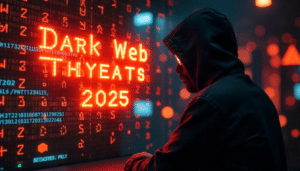Introduction
Besides 2025’s approach, the digital business environment transforms fast and presents new difficulties and hazards, such as the Dark Web. This is a corner of the web not searchable by any search engines. It has become a home for criminal activities on the internet. This is a very useful piece that intuitively gives the information to the readers about the emerging Dark Web threats.
Advanced Ransomware-as-a-Service (RaaS)
At 2025, Ransomware-as-a-Service’s decryption rate was estimated to be increasing and its performance was better as well:
- AI-augmented ransomware that learns to break through security measures
- More targeting of cloud-based systems
- Increasingly popularity and affordability of RaaS platforms
Quantum-Resistant Encryption Cracking Tools
With the advent of quantum computing technology, these new dangers come along with them:
- Tools constructed to hack quantum-resistant encryptions
- More vulnerable of the current encryption methods
- Uncovering of the data, previously thought to be safe
IoT Botnet Armies
Multiplication of IoT devices is seen as new devices in attack scenarios:
- The majority of the bots are reprogrammed IoT devices
- The most complex DDoS attacks on the most vulnerable infrastructure
- Engineering of hijacking smart city systems and industrial IoT networks
AI-Enhanced Social Engineering
Artificial Intelligence rules social engineering attacks:
- Realism in deep fake video and voice cloning
- AI-made unsophisticated phishing emails mimicking the human writing style
- Data stealing and information-gathering via social media bots
Biometric Data Theft and Spoofing
With the rise of biometric authentication, the related threats also become prevalent:
- The sale of the stolen biometric data on Dark Web marketplaces
- High tech biometric spoofing techniques
- Breaches of biometric-based security systems
Cryptocurrency-Based Money Laundering Services
Cryptocurrency as a channel for money laundering remains:
- Sophisticated crypto mixing services
- Decentralized finance platforms are used for Money laundering
- AI-executed crypto fraud schemes
Corporate Espionage-as-a-Service
The turning of corporate espionage into a business on the open internet:
- Data stealing services for the target company
- Insider nodding web platforms
- Industrial sabotage facilities
Supply Chain Attack Kits
A set of sophisticated tools for compromising supply chains:
- A set of ready-made tints keeping up with common supply chains flaws
- Service for the identification of weak areas in the supply chain of companies
- Auto-nets for the company that connects with the vendors
Zero-Day Exploit Marketplaces
The trading of still unrecognized vulnerabilities becomes more orderly:
- Bidding places for zero-day vulnerabilities
- Subscription options for frequent attacks with new exploits
- Increased cooperation between the exploit developers
Dark Web-Enabled Physical Threats
The intersection and intensification of both digital and physical threats are growing:
- Imaginations involved in real-world activities carried out through the Dark Web channels
- Products like smart home doors and buildings access systems being size]nt
- Dark Web markets for digital spam and security issues of company installations that violate patents and laws
Advanced Malware Obfuscation Techniques
Malware designers are now using evolved technologies such as machine learning to monitor them.
- Self-modified AI viruses that are able to develop constant code changes
- Cybercriminals develop malware that can easily pass any blind holes that machine learning security systems may have
- Artificial intelligence-driven steganography is used to make it more difficult for researchers to host malicious code in files that are considered to be safe
Decentralized Dark Markets
The transformation of Dark Web exchange platforms into more efficient systemic structures:
- Block-chain based decentralized markets, which can’t be easily seized
- A platform that facilitates illegal goods and services buying via person-to-person trading
- Rising use of privacy-enhancing cryptocurrencies in transactions
How can businesses protect themselves from these Dark Web threats?
The company can protect itself by implementing robust and secure cybersecurity measures, constantly updating security policies, adopting employee training programs, and utilize advanced and current threat detection and prevention systems.
Are small businesses at risk from Dark Web threats?
Yes, small businesses are a favorite target among attackers because they usually have lower cost earmarked for cybersecurity. They are considered the relatively easiest one the hackers can breach compared to the bigger organizations.
How often should businesses conduct Dark Web monitoring?
Continual Dark Web surveillance is advised. Most secure services on the web are now able to do real-time monitoring, which means businesses could get notification immediately once their data showed up on the Dark Web.
How can businesses stay updated on emerging Dark Web threats?
Firms can keep an eye on the rising Dark Web threat landscape by subscribing to cyber-space news just as if they are pursuing a degree in cyber-security, they out to read the news of the said sphere, joining groups and engaging in discussions with cyber-space professionals, and they could also take time to read the reports from security companies that focus on these Dark Web activities at least every month constantly.
What role does employee training play in mitigating Dark Web threats?
Employee training is very important. Many breaches occur as a result of human error, like when an employee is tricked by a phishing scam.
Regular trainings will be the right way to spot such to employees, meaning that they are less at risk for the success of potential attacks.
Conclusion
As we head to 2025, the threats from the underworld, which continue to grow in terms of evolving and becoming more modern, are mostly posed by them. Through this, a company should always be equipped with the right infrastructure and, even with an increasing number of issues, always be in a position to address them. Regularly a security test, employee upskilling, as well as, rolling out cost-effective detection platforms are the major steps one should take in dealing with such online threats.



